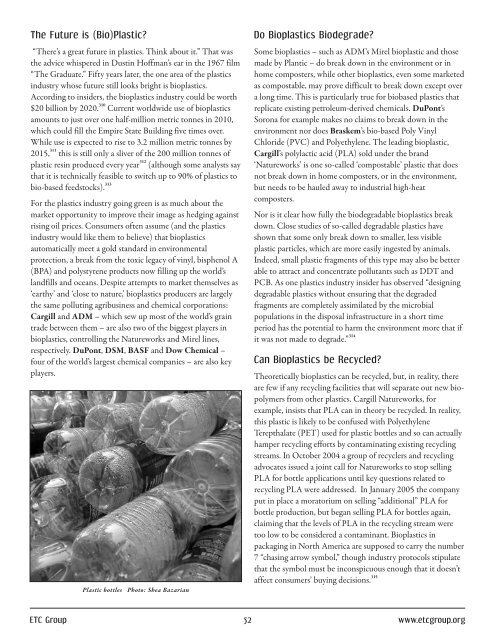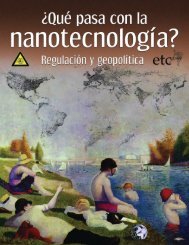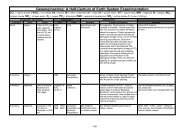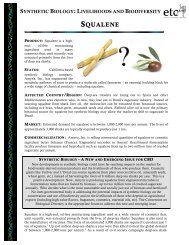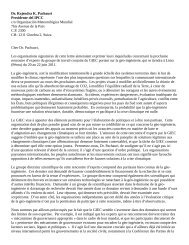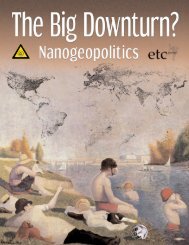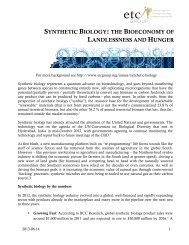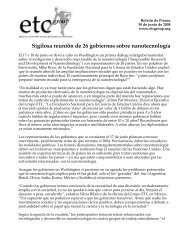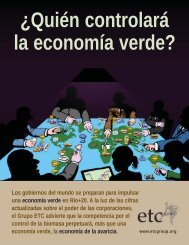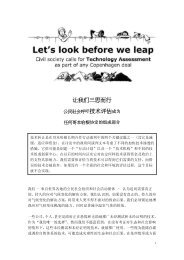The New Biomassters - Convention on Biological Diversity
The New Biomassters - Convention on Biological Diversity
The New Biomassters - Convention on Biological Diversity
Create successful ePaper yourself
Turn your PDF publications into a flip-book with our unique Google optimized e-Paper software.
<str<strong>on</strong>g>The</str<strong>on</strong>g> Future is (Bio)Plastic?<br />
“<str<strong>on</strong>g>The</str<strong>on</strong>g>re’s a great future in plastics. Think about it.” That was<br />
the advice whispered in Dustin Hoffman’s ear in the 1967 film<br />
“<str<strong>on</strong>g>The</str<strong>on</strong>g> Graduate.” Fifty years later, the <strong>on</strong>e area of the plastics<br />
industry whose future still looks bright is bioplastics.<br />
According to insiders, the bioplastics industry could be worth<br />
$20 billi<strong>on</strong> by 2020. 310 Current worldwide use of bioplastics<br />
amounts to just over <strong>on</strong>e half-milli<strong>on</strong> metric t<strong>on</strong>nes in 2010,<br />
which could fill the Empire State Building five times over.<br />
While use is expected to rise to 3.2 milli<strong>on</strong> metric t<strong>on</strong>nes by<br />
2015, 311 this is still <strong>on</strong>ly a sliver of the 200 milli<strong>on</strong> t<strong>on</strong>nes of<br />
plastic resin produced every year 312 (although some analysts say<br />
that it is technically feasible to switch up to 90% of plastics to<br />
bio-based feedstocks). 313<br />
For the plastics industry going green is as much about the<br />
market opportunity to improve their image as hedging against<br />
rising oil prices. C<strong>on</strong>sumers often assume (and the plastics<br />
industry would like them to believe) that bioplastics<br />
automatically meet a gold standard in envir<strong>on</strong>mental<br />
protecti<strong>on</strong>, a break from the toxic legacy of vinyl, bisphenol A<br />
(BPA) and polystyrene products now filling up the world’s<br />
landfills and oceans. Despite attempts to market themselves as<br />
‘earthy’ and ‘close to nature,’ bioplastics producers are largely<br />
the same polluting agribusiness and chemical corporati<strong>on</strong>s:<br />
Cargill and ADM – which sew up most of the world’s grain<br />
trade between them – are also two of the biggest players in<br />
bioplastics, c<strong>on</strong>trolling the Natureworks and Mirel lines,<br />
respectively. DuP<strong>on</strong>t, DSM, BASF and Dow Chemical –<br />
four of the world’s largest chemical companies – are also key<br />
players.<br />
Plastic bottles Photo: Shea Bazarian<br />
Do Bioplastics Biodegrade?<br />
Some bioplastics – such as ADM’s Mirel bioplastic and those<br />
made by Plantic – do break down in the envir<strong>on</strong>ment or in<br />
home composters, while other bioplastics, even some marketed<br />
as compostable, may prove difficult to break down except over<br />
a l<strong>on</strong>g time. This is particularly true for biobased plastics that<br />
replicate existing petroleum-derived chemicals. DuP<strong>on</strong>t’s<br />
Sor<strong>on</strong>a for example makes no claims to break down in the<br />
envir<strong>on</strong>ment nor does Braskem’s bio-based Poly Vinyl<br />
Chloride (PVC) and Polyethylene. <str<strong>on</strong>g>The</str<strong>on</strong>g> leading bioplastic,<br />
Cargill’s polylactic acid (PLA) sold under the brand<br />
‘Natureworks’ is <strong>on</strong>e so-called ‘compostable’ plastic that does<br />
not break down in home composters, or in the envir<strong>on</strong>ment,<br />
but needs to be hauled away to industrial high-heat<br />
composters.<br />
Nor is it clear how fully the biodegradable bioplastics break<br />
down. Close studies of so-called degradable plastics have<br />
shown that some <strong>on</strong>ly break down to smaller, less visible<br />
plastic particles, which are more easily ingested by animals.<br />
Indeed, small plastic fragments of this type may also be better<br />
able to attract and c<strong>on</strong>centrate pollutants such as DDT and<br />
PCB. As <strong>on</strong>e plastics industry insider has observed “designing<br />
degradable plastics without ensuring that the degraded<br />
fragments are completely assimilated by the microbial<br />
populati<strong>on</strong>s in the disposal infrastructure in a short time<br />
period has the potential to harm the envir<strong>on</strong>ment more that if<br />
it was not made to degrade.” 314<br />
Can Bioplastics be Recycled?<br />
<str<strong>on</strong>g>The</str<strong>on</strong>g>oretically bioplastics can be recycled, but, in reality, there<br />
are few if any recycling facilities that will separate out new biopolymers<br />
from other plastics. Cargill Natureworks, for<br />
example, insists that PLA can in theory be recycled. In reality,<br />
this plastic is likely to be c<strong>on</strong>fused with Polyethylene<br />
Terepthalate (PET) used for plastic bottles and so can actually<br />
hamper recycling efforts by c<strong>on</strong>taminating existing recycling<br />
streams. In October 2004 a group of recyclers and recycling<br />
advocates issued a joint call for Natureworks to stop selling<br />
PLA for bottle applicati<strong>on</strong>s until key questi<strong>on</strong>s related to<br />
recycling PLA were addressed. In January 2005 the company<br />
put in place a moratorium <strong>on</strong> selling “additi<strong>on</strong>al” PLA for<br />
bottle producti<strong>on</strong>, but began selling PLA for bottles again,<br />
claiming that the levels of PLA in the recycling stream were<br />
too low to be c<strong>on</strong>sidered a c<strong>on</strong>taminant. Bioplastics in<br />
packaging in North America are supposed to carry the number<br />
7 “chasing arrow symbol,” though industry protocols stipulate<br />
that the symbol must be inc<strong>on</strong>spicuous enough that it doesn’t<br />
affect c<strong>on</strong>sumers’ buying decisi<strong>on</strong>s. 315<br />
ETC Group 52 www.etcgroup.org


